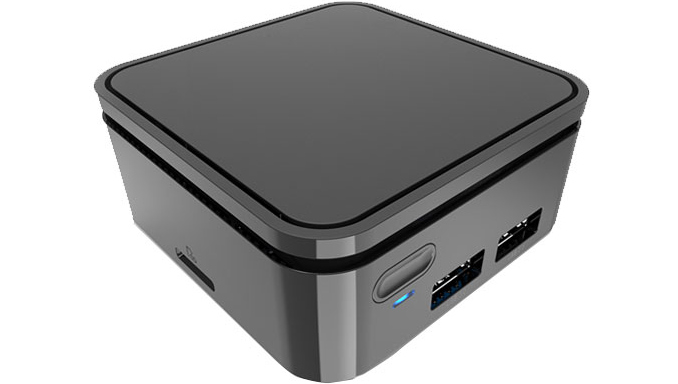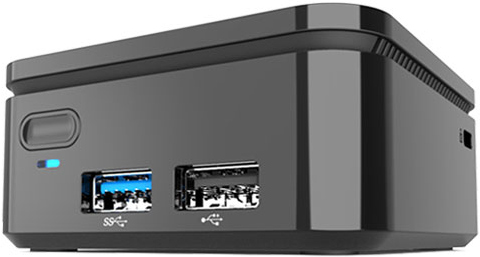ECS Quietly Adds PB01CF Ultra Compact PC to Lineup: a 5 Oz Apollo Lake Desktop
by Anton Shilov on May 5, 2017 11:00 AM EST- Posted in
- Systems
- Intel
- ECS
- Apollo Lake
- PB01CF

ECS has quietly added a new small x86 desktop computer into its lineup. The ECS PB01CF ultra-compact PC is powered by Intel’s Apollo Lake platform and uses an enclosure the size smaller than most wallets. The computer is clearly not a powerhouse, but it supports all the multimedia capabilities that Intel’s latest low-power chips have to offer.
The ECS PB01CF is based on Intel’s Celeron N3350 processor, a mobile SoC with two Goldmont cores clocked at 1.1-2.4 GHz, 2 MB cache and Intel’s HD Graphics 500 (Gen9) iGPU with 12 EUs. The SoC supports Intel's new multimedia playback engine that supports hardware-accelerated playback of 4K video from HEVC and VP9-based sources. The system comes equipped with 2 GB of LPDDR4 memory, 32 GB eMMC storage (not a lot, if you want to store UHD videos locally without using an external hard drive, but enough for streaming) and runs Windows 10 Home. As for connectivity, everything looks fairly standard here: a 802.11ac Wi-Fi module, a GbE controller, a microSD card reader, two USB Type-A headers, and one 4Kp30-capable HDMI output to connect to displays or TVs (note that the system does not have any analog connectors for monitors or audio). The PB01CF measures 7×7×3.1 cm and is powered by an external 24 W adapter.
| Brief Specifications of ECS 5-Ounce PC | |
| PB01CF | |
| CPU | Celeron N3350 2C/2T at 1.1 – 2.4 GHz frequency, 2 MB cache, iGPU |
| PCH | integrated |
| Graphics | Intel HD Graphics 500 (12 EUs) Gen9 |
| Memory | 2 GB LPDDR4 |
| Storage | 32 GB eMMC |
| Wi-Fi | Intel 802.11ac |
| Ethernet | Gigabit Ethernet with RJ45 connector |
| Display Outputs | 1 × HDMI (up to 4Kp30) |
| Audio | via HDMI |
| USB | 1 × USB 3.0 Type-A (5 Gbps) 1 × USB 2.0 Type-A (480 Mbps) |
| Dimensions | 70 mm × 70 mm × 31 mm (0.15 liters, 5 ounces) |
| PSU | External 24 W |
| VESA Mounts | 75 mm/100 mm |
| OS | Microsoft Windows 10 Home 64-bit |
From a performance and connectivity point of view, the ECS PB01CF is somewhat behind the company’s LIVA Z computers, which are positioned as universal systems for office and media-centric applications. By contrast, the PB01CF is considerably smaller while offering 4K hardware-accelerate video playback, which makes it a viable solution for content streaming or digital signage. In fact, the latter is one the primary applications that ECS positions the PB01CF for, apart from being a cheap office PC attached to the backside of the display, of course. Meanwhile, when compared to Compute Stick systems, the PB01CF has more USB ports, a card reader, GbE and active cooling.
ECS has not publicly announced pricing of the PB01CF and large retailers as well as price search engines do not list the product in their databases. Moreover, at press time ECS’ web site did not host any manuals or BIOS updates for the PB01CF, which may indicate that the manufacturer has not launched the device yet. Given the fact that the PB01CF does not seem to be designed for general public, it is possible that the PC is only going to be available via special channels with ECS as an OEM - a common avenue for ECS' business.
Related Reading:
Source: ECS













38 Comments
View All Comments
close - Friday, May 5, 2017 - link
When a site starts using intrusive ads I usually just turn on the adblocker. It's a good way of not cutting your nose to spite your face.takeshi7 - Friday, May 5, 2017 - link
Yeah, but I like AnandTech, so I'm OK with them getting ad revenue from me. Just not freaking fullscreen ads that load in when I've already scrolled down the page and forces me to scroll to the top in order to close.close - Friday, May 5, 2017 - link
That's exactly the point. Give them the ad revenue until it becomes an unbearable experience. That motivates them to cut back on garish ads that make you wonder how little price do some sites put on their image.shabby - Friday, May 5, 2017 - link
Just turned off my adblocker... jeez, on you go.helvete - Thursday, July 20, 2017 - link
Are you really deliberately watching the ads? Are you clicking them and buying stuff from the advertised company to support AT as well?mode_13h - Friday, May 5, 2017 - link
I still think the J4205 in NUC/mini-STX form factor would be the thing. I had to buy ASRock's mini-ITX board to get that chip, but it's really the Apollo Lake you want.manikandan - Friday, May 5, 2017 - link
nice pc pretty cool oneKakti - Saturday, May 6, 2017 - link
It's really disappointing that Optane isn't supported by Celerons, Pentiums or M/Y-series processors. I would think this is the primary target for gen 1 where the sizes are so low (16gb and 32gb). In any event, this is potentially a nice little htpc box with the hardware decode.Death666Angel - Saturday, May 6, 2017 - link
M / Y series I can understand, but Optane is a high cost option, so it wouldn't make sense for budget CPUs I think. Though for me, the whole idea of 16/32GB ultra high speed caching is not so clear on the consumer side.edcoolio - Saturday, May 6, 2017 - link
Looks like USB sticks are their target. Basically the same, but with more "added value" by way of more ports, including wired ethernet.Regardless, I agree with what others have said regarding RAM. Why load it with Win 10 64 bit then gimp it with 2GB? Not enough storage for much of anything. I'm not sure what they are going for here, but in the race to the bottom, sometimes you can go to low.